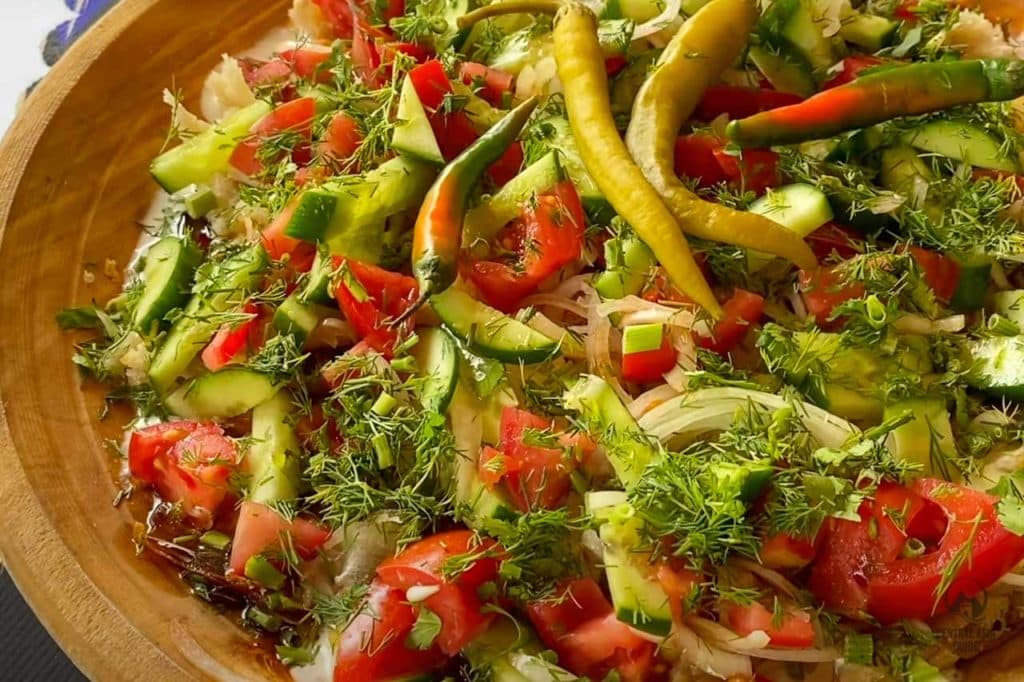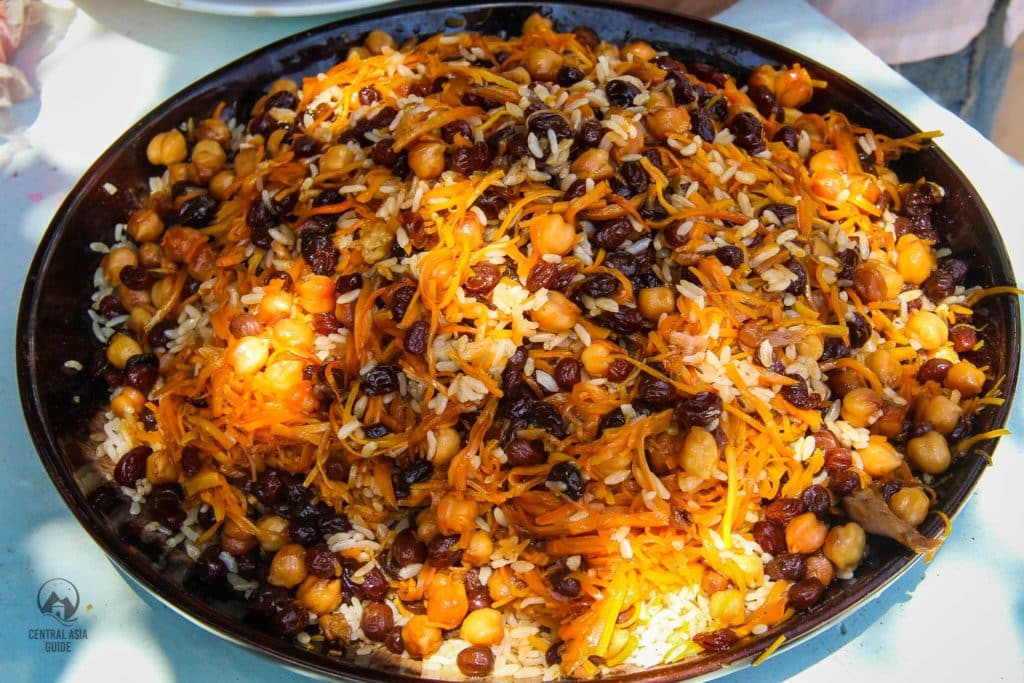Tajik Food
Tajik Cuisine
Tajik cuisine is certainly Central Asian with plenty of grilled meats and dairy products, however with an influence by Afghanistan, Russia, and even Iran. Tajik meal contains a variety of fruits, meat, and soup dishes. The most popular dishes are “kabuli pulao” (or “qabili palau”) which is a variety of Central Asian plov and Samanu or samsy (samosa).
Tajik starters are small dishes such as dried fruit, nuts, and halva, followed by soup and meat and often completed with plov. Bread and tea still play the vital role in the life of Tajiks, there will always be a kettle on the boil and a few tea bowls filled with a light, steaming tea. Apart from the most common Central Asian foods which were described in the Uzbek cuisine and Kyrgyz cuisine pages, Tajik cuisine has its own unique dishes as well including for example the Qurutob.
Tajik Dishes
Tajik cuisine often includes fresh herbs, such as cilantro and parsley, as well as dried fruits, such as apricots and raisins. Dairy products, such as yogurt and sour cream, are also commonly used in Tajik cooking. Overall, Tajik cuisine is known for its bold flavors, hearty portions and warm hospitality.

Qurutob
Qurutob is a national dish of Tajikistan, also known as a bread salad. It is also a very Tajik dish while most other Central Asian dishes are eaten all around the region. This dish is prepared using qurut (the dried salty balls made from sour milk or yogurt) which are eaten in other parts of Central Asia. Quruts are dissolved in water, and the resulting liquid, salty in flavor, is used as the base of the dish.
The liquid is poured over strips of а thin flatbread. Before serving the dish, vegetables such as onions fried in oil until golden and other fried vegetables together with fresh herbs and sometimes also other fresh vegetables.
Kabuli pulao
This is a rice dish that is similar to Plov but is made with chickpeas and raisins. It is a popular dish in the northern regions of Tajikistan (and is close to some regional Uzbek plovs). Puloa is made of steamed rice mixed with raisins, carrots, and beef or lamb. There are different variations depending on the region. Kabulli Plov is one of the types of pilaf, also called osh in Tajik.


Shurbo
Shurbo means “soup” in Tajik. There are many types of “shurbo” in Tajikistan, yet the traditional one contains potatoes, carrots,s and chunks of meat and fat. Shurbo is one of the most common meals you will find throughout Tajikistan and all Central Asia.
Samanu
This is a sweet pudding made from sprouted wheat and is often served during the Persian New Year holiday (Navruz). Other Central Asian countries have it but name it differently, for instance in Uzbekistan is Sumalak, and in Turkmenistan Sumalek.
Samanu is a sweet paste made from germinated wheat (young wheatgrass) and wheat flour, which is prepared especially for Noorus (beginning of spring) in a large pot. This practice has been drafted back to the pre-Islamic Sasanian Persian Empire.

Mastoba
Mastoba is eaten elsewhere in Central Asia but the name varies a bit as in Uzbekistan it is called Mastava. This soup consistists of meat, rice, and vegetables. It is typically prepared with seasoned chunks of meat of beef or mutton that are browned alongside tomatoes, onions, garlic, carrots, sweet peppers, potatoes, spices, and rice, and then boiled in water until all the contents are tender.
Thick and satisfying, the Mastoba soup is traditionally served from an oval-shaped bowl known as kasa, tavak, or pialah in Tajik. It usually comes with katyk, a type of Tajik sour milk and topped with freshly chopped coriander and ground pepper.
Tushbera
This is a type of soup that is made with lamb or beef dumplings and is served in a clear broth with fresh herbs and spices. Tushera resembles to pelmeni, ravioli, or pasta with meat in it.
Tajik tea culture
Tajikistan has a rich tea culture that dates back centuries. Tea is a significant part of Tajik hospitality and social life and is often served during family gatherings, weddings, and other social events. Tea in Tajikistan is typically served in small glasses called “piala” brewed strong and dark and is often sweetened with sugar or honey. Tajiks also love green tea and they drink it with food or with a variety of sweets and snacks, such as dried fruits, nuts, and pastries. It is customary to serve guests the best food and drink available, and tea is no exception.
Additionaly tea’s role in social life, it is also used for medicinal purposes in Tajikistan. Certain herbs and spices, such as mint and chamomile, are added to tea to treat a variety of ailments, from colds and coughs to digestive issues. Tea culture is deeply ingrained in the country’s history and tradition, and remains an important part of daily life for many Tajik people.
Shirchoy (milk and butter tea)
Shirchoy is a type of tea that is popular in Tajikistan as well as other Central Asian countries. Shirchoy tea is made by boiling water with black tea leaves and then adding milk and butter to the mixture. To make shirchoy, the tea leaves are first steeped in boiling water for several minutes to create a strong brew. Then, milk and butter are added to the mixture and allowed to simmer over low heat for several minutes until the tea is rich and creamy.
Shirchoy is a warming and comforting beverage that is mainly enjoyed during cold winter months. The high-fat content of the milk and butter also makes shirchoy a good source of energy and nutrients, which is especially important for people living in regions with harsh climates. For culinary uses, shirchoy is also used for medicinal purposes in Tajikistan. It is believed to help soothe sore throats and colds and is often given to sick people as a remedy, as well as shirchoy enjoyed by many people throughout the country.
Best destinations to enjoy Tajik Cuisine
Page updated 2.2.2023